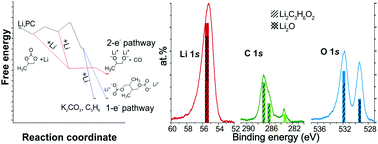Revising the pathways of the Li reaction with organic carbonates†
Abstract
The metallic lithium electrode has major concerns such as extremely high reactivity and nonuniform needle-like electrodeposition, limiting its wide application as a negative electrode in secondary batteries. Its reactions with the electrolyte leading to solid electrolyte interphase (SEI) formation play an important role, and controlling its composition and properties can help to overcome both difficulties. Even though solid electrolyte interphase chemistry and properties seem to be well known, many surface chemistry experiments reported are not perfect with respect to the purity needed for Li studies and can be interpreted alternatively. Here, we studied reactions between lithium and propylene carbonate and ethylene carbonate in model reactions realized in an ultra-high vacuum. In addition to the already reported reaction pathway yielding lithium carbonate and semicarbonate, our theoretical (DFT) modeling confirms the preference of alternative routes. Along with the most beneficial final lithium carbonates, dilithium 1,2-dialkoxide (DD) can form barrierlessly as a final product by two-electron transfer. Experimental XPS/NEXAFS studies of gas phase and solid–gas model reactions revealed that in both cases DD is the main reaction product. Understanding of the discovered reaction pathway can also be essential for reactions in liquid electrolytes, although the low electric conductivity of the SEI makes it less probable.



 Please wait while we load your content...
Please wait while we load your content...